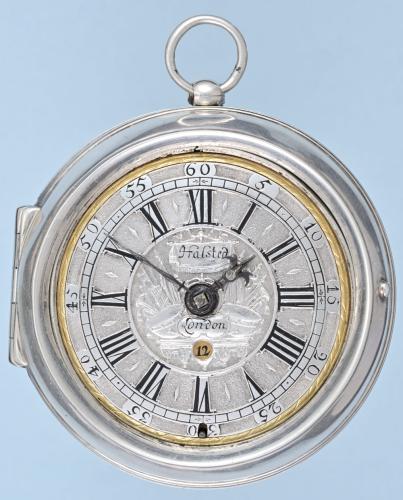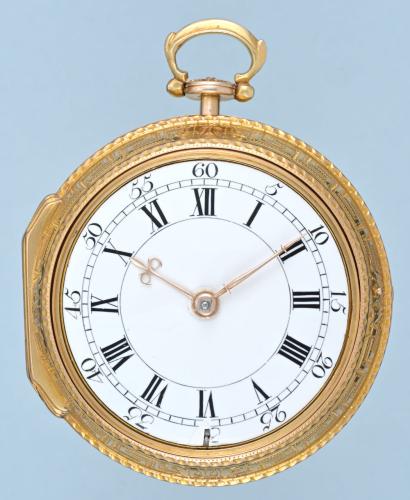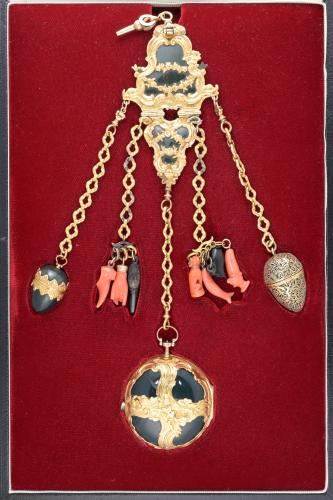










This object is eligible for a Certificate of BADA Provenance
The BADA Standard
- Since 1918, BADA has been the leading association for the antiques and fine art trade
- Members are elected for their knowledge, integrity and quality of stock
- Our clients are protected by BADA’s code of conduct
- Our dealers’ membership is reviewed and renewed annually
- Bada.org is a non-profit site: clients deal directly with members and they pay no hidden fees
An 18th Century English quarter repeater in a fine gold and enamel case and chatelaine by Moser. Full plate fire gilt movement with signed gilt dust cover. Decorative silver pierced and engraved cock with large diamond endstone in a polished steel setting. Silver pierced and engraved signed plate for the gold regulator disc. Fusee and chain with worm and wheel barrel setup between the plates. Converted to English lever escapement, plain three arm gilt balance, blue steel spiral hairspring.
Push pendant quarter repeating on two blocks in the case. Fine white enamel dial signed for the retailer, Grignion, Roman and Arabic numerals, fine diamond set hands. Fine diamond set gold and enamel consular case with gold push pendant and bow, maker's mark "PM". The back with an exceptionally finely painted en grisaille scene of two Greek sibyls in a garden scene, signed Moser. F(ecit) in the lower right corner. Border of white enamel faux split pearls set in a diamond set bezel of dark translucent blue champleve enamel on an engraved ground. Matching small chatelaine of two cartouches joined by a ribbon. Attached a matching gold and enamel folding crank key.
Signed J Snelling London
Condition report
A fine and rare enamel watch. There are probably only about 20 surviving examples of Moser's enamelled watches. An example housing a movement by Mudge and Dutton with a very similar scene en grisaille is in the Queen's collection (RCIN 33996). George Michael Moser was born in Schaffhausen on January 17, 1706. He studied chasing and gilding under his father Michael, an engineer and coppersmith. He moved to London in 1726 and worked for John Valentine Haidt, goldsmith and watch chaser. By 1737 he was working on his own account at Craven Buildings off Drury Lane. In addition to chasing he also produced fine enamel cases. Both he and his daughter, Mary Moser, were Founder Members of the Royal Academy of Arts, George Michael also taking on the role of Keeper of the Royal Academy Schools. He designed the great seal of George III and painted enamel portraits of the royal children for Queen Charlotte. Moser continued to work at least until the late 1770's, and was active for the Royal Academy until the end of his life. When Moser died in January 1783 a eulogy written by Sir Joshua Reynolds, praised him as possessing "a universal knowledge in all branches of painting and sculpture, which perfectly qualified him for the place that he held in the Academy he may truly be said, in every sense, to be the father of the present race of artists.". He is buried in the churchyard of St Pauls, Covent Garden. Peter Mounier of Frith St, Soho, was the preferred casemaker of the best watchmakers in the later half of the 18th Century, most notably Mudge.The BADA Standard
- Since 1918, BADA has been the leading association for the antiques and fine art trade
- Members are elected for their knowledge, integrity and quality of stock
- Our clients are protected by BADA’s code of conduct
- Our dealers’ membership is reviewed and renewed annually
- Bada.org is a non-profit site: clients deal directly with members and they pay no hidden fees














